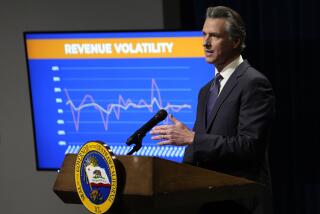Mayor Presents a ‘Doomsday’ Budget for N.Y. : Cities: Proposal would turn off streetlights, idle workers and close libraries, clinics and a zoo. It also would boost taxes.
- Share via
NEW YORK — New York Mayor David N. Dinkins on Friday presented a “doomsday” budget that would pare the Big Apple toward a seedy core, boosting taxes while turning off 25% of the street lights, laying off 28,000 city workers and closing many libraries, clinics and the Central Park Zoo.
All week, New Yorkers have heard grim tidbits about what bad times have wrought, including a somber televised speech in which the mayor suggested that citizens themselves might have to pick litter off the streets.
But Friday was the first time the dreary details were offered in bulk. This city of 8 million people faces a $3.5-billion gap in its $28.7-billion budget for the fiscal year beginning in July. Not just something--but many things--have to go.
Dinkins begged for help.
“No adjectives can explain the consequences of cuts so large,” the mayor said. “For unless our friends in labor, in the state Legislature, in the governor’s office . . . and in the City Council step forward and help out, the unthinkable will become the unavoidable.”
East Side, West Side and all across the town, there are suggestions that at least part of this hand wringing is a posture. Dinkins hopes for givebacks from labor unions and direct aid from the state, itself $6 billion in the red.
New York City is in trouble, no doubt. The tab is enormous. But Dinkins, Gov. Mario M. Cuomo, union leaders and City Council members are all waiting to see if someone else will reach for the check.
Each has much at stake, whether it be stature for the politicians or wages for the rank-and-file. On Friday, Dinkins turned up the pressure on the others. His budget cuts would leave New York darker, dirtier, poorer and sicker. Proposed moves:
--Taxes: Increases of nearly $1 billion, primarily in property and personal income taxes.
--Layoffs: 22,000 full-time workers, including 2,800 teachers and 6,000 part-time workers.
--The homeless: Close several shelters and reduce the security and medical care in others.
--Sanitation: Dismiss most street cleaners and suspend for one year the city’s program for recycling.
--Fire: Close two engine companies and reduce the number of fire investigators.
--Health: Eliminate the city’s program for lowering infant mortality rates, discontinue hearing and vision exams for schoolchildren, reduce by half the number of lead-paint inspections.
--Hospitals: Close six walk-in clinics established to reduce pressure on emergency rooms and eliminate all dental clinics and out-patient pharmacies.
--Police: Delay both 1992 police academy classes by three months and reduce by half the number of school crossing guards.
--Parks: Close the Central Park Zoo, half of the city’s beaches and several recreation centers.
--Transportation: Turn off 25% of the city’s 295,000 street lights and double the price of the Staten Island ferry to $1 per round trip.
The proposals have something to make everyone gasp. “If they’re going to close the Central Park Zoo, they may as well close the Statue of Liberty,” said Aldo Vitalli, a street vendor.
The City Council has until June 30 to pass a new budget. By law, the city must begin its fiscal year with a balanced budget or face a takeover by the state Financial Control Board.
New York has been hurt by plunging revenues, due in large measure to the recession. Federal and state aid also has declined. Then, too, the city has a tradition of big government and assuming responsibilities that most other cities do not such as city colleges, city hospitals and public housing.
More to Read
Sign up for Essential California
The most important California stories and recommendations in your inbox every morning.
You may occasionally receive promotional content from the Los Angeles Times.










